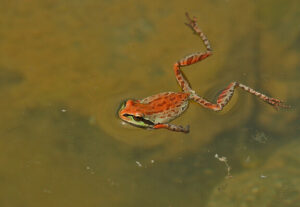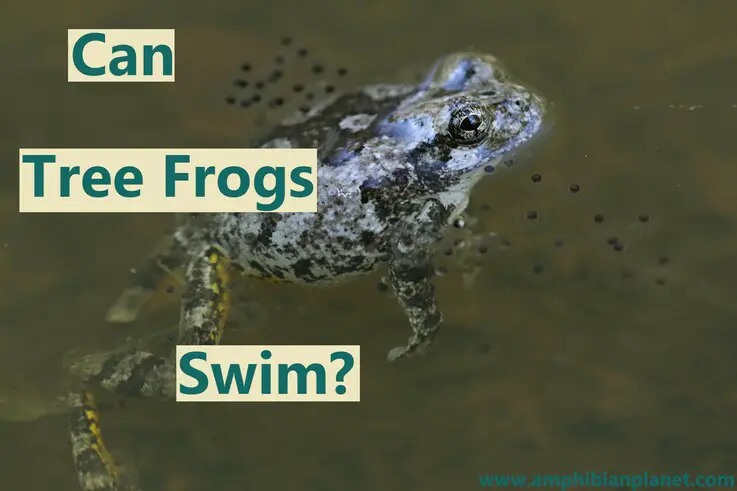Most people know that frogs that love to hang around ponds and other water bodies are very efficient swimmers. But since tree frogs spend most of their time in or around trees, you may be wondering if they too can swim.
Tree frogs can swim – however, they generally live a very terrestrial life, so they are not strong swimmers. Tree frogs typically begin their lives as tadpoles that live in the water, and as adults, they return to the water to breed and lay their eggs. As such, they are natural-born swimmers.
Adult tree frogs are highly adapted for their arboreal lifestyle (life in the trees) – they have small light bodies, and large, round toe pads that help them cling to branches.
However, these features are not very good for swimming – so tree frogs can not swim as efficiently as pond frogs that have features highly adapted for swimming.
Tree Frogs Start Their Lives in Water
Most tree frogs start their lives as tiny tadpoles that live entirely in the water. Tadpoles are very different from adult tree frogs. This is because they are highly adapted for their fully aquatic life.
They have external gills and a flat paddle-like tail fin to help them move in the water.

They swim by flapping their tail from side to side and are excellent swimmers.
Tadpoles Transform Into Froglets
After a period of one to two months, (depending on the species), the tadpoles go through a process known as metamorphosis. In this process, they lose the features that help them live in the water and develop features more suitable for living on land.
During this process;
- They lose their gills and get well-developed lungs for breathing air
- The tail shortens and is eventually absorbed into the body
- They develop strong legs for moving on land
Once this process is complete, tiny froglets (small versions of adult frogs), will leave the water for a life on land.
These froglets will grow into adult tree frogs and once they mature, they will go back to the water to breed and lay their eggs.
Adult Tree Frogs Are Not Very Strong Swimmers
Adult tree frogs spend most of their time in or around trees near a water source but very rarely go into the water. For this reason, their features are highly suited for a life on land, rather than in the water – so they are not very strong swimmers.
However, they are still fairly decent swimmers and will return to the water during the breeding season to mate and lay their eggs.

Why Adult Tree Frogs Are Not Strong Swimmers
Tree frogs generally have small light bodies that allow them to sit on leaves and cling to weak branches without falling. They also have long toes that allow them to wrap around small branches.
Their toes have large, round toe pads that help them cling to branches. These toe pads work like suction cups to help the frog cling on to wet leaves and other smooth surfaces. These “sticky toes” mean tree frogs can even cling to glass!
As efficient as these features are for climbing, they are not very good for swimming.
Aquatic frogs generally have fully webbed footing and strong powerful hind legs for propelling the frog when in the water.
Since tree frogs lack these features, they are not strong swimmers.
How Do Tree Frogs Stay Hydrated?
Frogs, salamanders, and other amphibians do not drink water using their mouths as we do. Rather, they drink water by absorbing it through their semi-permeable skin.
To stay hydrated, most frogs require direct access to fresh and clean water. However, since tree frogs do not spend much time in the water, they have come up with other ways of staying hydrated.
Most tree frogs stay in very humid environments, so they can hydrate by absorbing the moisture around them through their skin.
If the humidity levels around them are low (such as in the dry season) tree frogs have another way to hydrate. They will sit outside on cool nights – and when they return to their dens, condensation will form on their cold skin allowing them to rehydrate.
This is similar to the condensation that happens when you take a cold drink out of the refrigerator.
Using this technique, some tree frogs can stay for several months without direct access to water.
However, if water is readily available (particularly shallow water), tree frogs will go for a soak to keep cool and “drink” water through their skin.
How Do Tree Frogs Swim?
Like all frogs, tree frogs swim by pushing water backward with their hind legs. The legs are usually kicked back simultaneously, but they can sometimes move independently, particularly during slow swimming.
Here is a video of a tree frog having a swim:
Can Tree Frogs Breathe Underwater?
Tree frog tadpoles (baby tree frogs) can breathe underwater using their gills. The gills have thin membranes and a network of blood vessels. These membranes absorb dissolved oxygen from the water and move it into the bloodstream.
At the same time, carbon dioxide from the bloodstream passes out through the membranes, and into the water. This gaseous allows tree frog tadpoles to breathe underwater, just like fish.
Once the tadpoles transform into froglets, they lose their gills. Instead, they develop to breathe using their lungs, through their skin, and thin membranes in their mouths and throat.
While underwater, frogs can not breathe with their lungs, so they have to hold their breath and breathe entirely through their skin (cutaneous respiration ).
Dissolved oxygen in the water that comes in contact with their skin is diffused into their bloodstream, and carbon dioxide is released from the bloodstream into the water.
However, this method of breathing usually does not give frogs all the oxygen they need, so they can only be submerged for a limited time before they have to resurface to breathe air with their lungs.
How Long Can Tree Frogs Stay Underwater?
How long a tree frog can stay underwater depends on how long it can hold its breath and how much oxygen it can absorb from the water through its skin.
This is usually determined by: How much dissolved oxygen there is in the water, the species, and the temperature. Depending on these factors, tree frogs can stay underwater anywhere from a few seconds, to several minutes.
1. How Much Dissolved Oxygen Is in the Water
Fast-moving water contains more oxygen than stagnant water. This is because oxygen from the atmosphere is dissolved into the water easier.
If water is very stagnant, oxygen only dissolves on the water’s surface, and anything below the upper layer of the water will have a low oxygen content.
Aquatic plants and algae also affect how dissolved oxygen is in a body of water. During the daylight hours, they produce oxygen through photosynthesis and release it into the water.
At night, aquatic plants and algae will use up dissolved oxygen in the water via aerobic respiration and release carbon dioxide into the water.
For these reasons, the concentrations of dissolved oxygen in water with lots of photosynthesizing aquatic vegetation will be highest in the mid-to-late afternoon when photosynthesis rates are greatest and will reach the lowest concentrations just before the sun rises the next morning.
Frogs will be able to get more oxygen from water with a high oxygen content, and thus be able to stay underwater for much longer.
2. Species
Some tree frog species are much stronger swimmers than others. For this reason, species also plays a role in determining exactly how long a particular tree can stay underwater.
Some tree frogs can only stay submerged for a few seconds, while others can last for much longer.
3. Temperature
Frogs are ectothermic (cold-blooded) animals, so the environmental temperatures will affect their rate of metabolism. At higher temperatures, they will have a higher metabolic rate, meaning they have a greater oxygen demand.
At lower temperatures, the opposite is true. Frogs will have a lower metabolic rate meaning they have a lower oxygen demand.
Also, the temperature will affect the oxygen content of the water. More oxygen will dissolve into the water at colder temperatures, than at warmer temperatures.
This means tree frogs can stay underwater at lower temperatures for much longer than they can at warmer temperatures.
Can Tree Frogs Drown?
Even with their ability to breathe underwater through their skin, tree frogs can drown. Remember, adult frogs have lungs that they use to breathe air, and If their lungs fill with water, they can drown.
The oxygen they absorb from the water through their skin is usually not enough to meet all their oxygen needs, so they can only stay submerged for a limited time before they will have to surface to breathe air with their lungs.
If a tree frog dives into water so deep that it can not surface in time, it will drown.
Frequently Asked Questions
Can tree frogs go in the water? Tree frogs can go in the water, but generally prefer not to do so as they are not strong swimmers. However, if a tree frog has to go in the water (such as swimming across a puddle), it can certainly do so.
During the breeding season, many tree frogs will migrate to fishless ponds and other water bodies to breed and lay their eggs.
Are tree frogs good swimmers? Tree frogs are not good swimmers, but they can still swim fairly decent. Aquatic frogs generally have fully webbed feet for propelling the frog in the water. Tree frogs, on the other hand, have long toes with sticky toe pads to help them cling onto branches.
This difference in anatomy means tree frogs can not swim as strongly as aquatic frogs can.
Can green tree frogs swim? Green tree frogs can swim, but they are not good swimmers. They generally on go to the water to reproduce, but spend will spend very little time there outside of the breeding season.
Can gray tree frogs swim? Gray tree frogs can swim, but like other tree frog species, they are not good swimmers. They will generally avoid water and only go there to reproduce. Unlike aquatic frogs which have fully webbed feet to help them swim, gray tree frogs have sticky toe pads to help them climb.
Final Thoughts
Tree frogs typically start their lives as fully aquatic tadpoles; in this stage, they have gills, flat-paddle-like tails, and are very strong swimmers.
Over time, the tadpoles will grow and go through metamorphosis and transform into froglets that live entirely on land. These froglets will grow into adult tree frogs that spend the majority of their time in or around trees, usually only going to the water during the breeding season.
Adult tree frogs can swim, but they are not strong swimmers because their anatomy is better suited for their arboreal (living in trees) lifestyle than it is for swimming.


